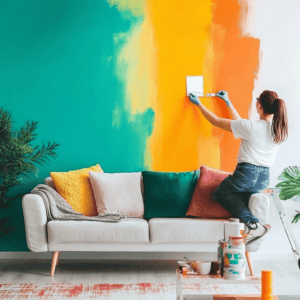Introduction to Future of the Texture Paint
Texture paint is a distinct category of paint that adds depth and dimension to surfaces through various techniques and materials. Unlike standard paint, which typically results in a smooth finish, texture paint creates a tactile surface, providing both aesthetic appeal and practical benefits. It is available in a wide range of formulations that cater to different textures, including stucco, sand, and splatter, making it a versatile option for both residential and commercial applications.
In residential settings, texture paint is often used to enhance walls and ceilings, transforming ordinary spaces into visually engaging environments. From living rooms to bedrooms, these textured surfaces can conceal imperfections while adding character and warmth to a home. In commercial spaces, texture paint is frequently employed in lobbies, offices, and retail areas, serving not only a decorative purpose but also promoting durability and ease of maintenance. The popularity of texture paint in both sectors stems largely from its ability to combine style with functionality; it can withstand wear and tear better than traditional paint while contributing to a unique aesthetic.
The historical journey of texture paint can be traced back to the early 20th century when artists and homeowners began experimenting with various techniques to elevate the look of their interiors. Over the years, advancements in paint formulations and application methods have further enhanced the versatility and effectiveness of texture paints. With the rise of DIY culture, many homeowners now embrace texture paint as an accessible way to personalize their spaces.
As the texture paint industry continues to evolve, it is essential to recognize its role not only in home decors but also as a practical solution for numerous decorative challenges. With an ever-expanding array of options, texture paint remains a favored choice for those looking to enrich their environments.

Current Trends in the Texture Paint Market
In recent years, the texture paint market has evolved significantly, reflecting changing consumer preferences and technological advancements. One of the most notable trends is the growing demand for eco-friendly and sustainable products. As consumers become more environmentally conscious, manufacturers are responding by developing texture paints that utilize low-VOC (volatile organic compound) formulations and natural ingredients. These eco-friendly options not only minimize environmental impact but also appeal to a demographic that prioritizes health and safety in their living spaces.
Moreover, the innovation in textures and finishes has become a defining characteristic of the contemporary texture paint landscape. With advancements in technology, manufacturers are creating a diverse array of textures, from smooth matte to intricate 3D patterns. This variety allows homeowners and designers to express creativity and individuality in their projects. Additionally, the introduction of smart technology in paints has led to the development of finishes that change color based on temperature or lighting conditions, adding a dynamic element to interior and exterior spaces.
Another significant trend is the increasing demand for custom solutions. Homeowners today desire unique aesthetics that reflect their personal style, prompting paint manufacturers to offer customizable products. The availability of various texture options, colors, and finishes allows for tailored applications that can meet specific design needs. This trend is particularly prominent in the commercial sector, where businesses are looking to create distinctive atmospheres to enhance brand identity.
Lastly, changing consumer preferences are increasingly shaping the trajectory of the texture paint market. Customers are seeking products that not only fulfill practical needs but also enhance aesthetic appeal. As trends continue to evolve, the industry will need to adapt to consumer demands, balancing innovation with sustainability, customization, and quality.

Technological Innovations in Texture Paint Production
In recent years, the texture paint industry has witnessed significant technological advancements that are transforming the production and application processes. One notable innovation is the integration of blockchain technology into the supply chain. This decentralized ledger system enhances transparency, enabling manufacturers and consumers to track the origin of raw materials and monitor the entire production process. Such transparency not only builds consumer trust but also ensures that the products meet safety and environmental standards.
Additionally, advancements in manufacturing processes have played a crucial role in improving the quality and performance of texture paints. Modern production techniques, such as automated mixing and precision formulation, allow manufacturers to achieve consistency in texture and color. These innovations also reduce waste, making the production process more sustainable. Innovations like 3D printing are being explored as well, allowing for the creation of customized textures that cater to specific consumer preferences, thus enhancing the overall user experience.
The integration of smart technology in texture paint application and curing processes poses another compelling development in the industry. Smart devices equipped with sensors can now assess environmental conditions in real-time, adjusting application methods to optimize adhesion and drying times. This not only enhances the quality of the finish but also reduces the likelihood of imperfections, such as bubbling or cracking. Furthermore, smart technology can provide users with detailed feedback, guiding them to achieve superior results in their painting projects.
These technological innovations collectively signify a progressive shift in the texture paint industry, spotlighting the commitment to producing high-quality products while addressing consumer needs. As the industry continues to evolve, the incorporation of these technologies is expected to lead to further enhancements, paving the way for a more efficient and customer-oriented future.

Impact of Environmental Considerations on Texture Paint
The texture paint industry is undergoing significant transformations as environmental considerations increasingly influence market dynamics. Growing awareness of ecological impacts in the construction and decoration sectors has necessitated a shift towards more sustainable practices. One critical aspect of this transformation is the regulation surrounding volatile organic compounds (VOCs). These compounds are known to contribute to air pollution and can cause health issues for consumers and workers alike. Consequently, many regulatory bodies worldwide are tightening restrictions on VOC emissions, compelling manufacturers to reformulate their products to comply with these new standards.
This heightened scrutiny has led to a rising demand for low-impact texture paints. Consumers and industry professionals alike are becoming more conscious of the materials they use, driving the market toward offerings that boast lower VOC content and minimal environmental impact. The preference for environmentally friendly products has fostered innovation within the industry, prompting companies to explore alternative ingredients such as water-based formulations and natural pigments. These advancements not only align with ecological goals but can also enhance the overall performance and durability of the paint.
Moreover, the industry’s shift towards greener practices extends beyond the composition of paint products. Manufacturers are increasingly adopting sustainable production methods and practices, focusing on efficient resource utilization, waste management, and energy conservation. This commitment improves their environmental footprints and resonates with a consumer base that prioritizes sustainability. The integration of eco-friendly packaging and promotional messaging that highlights these efforts further strengthens brand loyalty and appeal.
As environmental concerns continue to evolve, the texture paint market must adapt to meet both regulatory demands and consumer preferences. Embracing a holistic approach towards sustainability reflects the industry’s recognition of its role in promoting a healthier environment for future generations.
Challenges Facing the Texture Paint Industry
The texture paint industry, while demonstrating considerable growth and innovation, is not without its challenges. One of the primary obstacles is market saturation. With an increasing number of companies entering the texture paint market, competition has intensified, leading to a dilution of market share among existing brands. This saturation compels manufacturers to differentiate themselves through unique product offerings or superior customer service, which can strain resources, particularly for smaller companies.
Another challenge is the fierce competition faced from alternative wall finishes. Traditional paints, wallpapers, and innovative materials like cladding and tiles provide consumers with a broad range of options. These alternatives often promise easier application and lower maintenance requirements, making them attractive choices for consumers. The texture paint industry must innovate to compete effectively by highlighting the unique benefits of texture paints, such as aesthetics and customizable designs.
Additionally, fluctuating raw material prices pose a significant challenge, impacting production costs and profit margins. The sourcing of key materials used in texture paint formulations is often subject to market volatility, which can lead to unpredictable pricing structures. Companies may need to invest in strategic partnerships with suppliers to stabilize costs or seek alternative materials, which might enhance sustainability but also requires research and development efforts.
To navigate these challenges effectively, texture paint companies must adopt a proactive approach. This includes investing in marketing strategies that emphasize the value proposition of texture paints compared to alternatives. Furthermore, companies should prioritize innovation in their product development processes while also focusing on cost management and supply chain optimization to mitigate the effects of material price fluctuations. By addressing these hurdles head-on, the texture paint industry can position itself for continued growth and resilience in the evolving market landscape.
Emerging Markets and Opportunities for Growth
The texture paint industry is witnessing a notable expansion, particularly in emerging markets characterized by rapid urbanization and infrastructure development. Regions such as Asia-Pacific, Latin America, and parts of Africa are becoming focal points for growth, driven by an increasing demand for aesthetically pleasing and durable painting solutions. Urban populations are growing, prompting investments in residential and commercial projects, which in turn boosts the demand for innovative texture paint products.
As cities expand, the need for well-designed spaces becomes essential, thus creating significant opportunities for manufacturers and suppliers in the texture paint market. Developing regions are beginning to prioritize aesthetics and functional qualities in their construction projects, resulting in a surge in demand for texture paint that can meet diverse climate and usage challenges. This aligns with a global trend towards personalization and customization in building materials, prompting manufacturers to innovate and cater to local preferences.
Strategic partnerships between local businesses and established texture paint manufacturers can further unlock opportunities for growth. Such collaborations not only enhance distribution networks but also facilitate knowledge transfer regarding product application techniques and market dynamics. Furthermore, leveraging advanced digital marketing strategies can help companies penetrate these emerging markets more effectively, ensuring they reach the appropriate audience while emphasizing the unique advantages of their texture paint products.
Market entry strategies must be tailored to each region’s regulatory environment and cultural preferences. Companies should conduct comprehensive market research to identify localized needs and preferences, allowing them to provide customized solutions that resonate with the target demographic. By understanding these emerging markets and implementing effective strategies, stakeholders within the texture paint industry can position themselves favorably, harnessing the potential for significant growth and market share acquisition in the coming years.

The Role of Social Media and Digital Marketing in Texture Paint Sales
In today’s competitive marketplace, social media and digital marketing play pivotal roles in the sales and promotion of texture paint products. These modern strategies have radically transformed how businesses communicate with potential customers and foster brand loyalty. One of the most effective tactics within this paradigm is influencer marketing, where companies collaborate with well-known personalities to showcase their products. Influencers, often considered trusted figures, possess the ability to create authentic connections with their followers, consequently driving engagement and interest in texture paint offerings.
Furthermore, user-generated content has emerged as a significant factor in modern marketing. This phenomenon encourages customers to share their experiences, whether through photos of their newly painted walls or videos demonstrating application techniques. Such authentic feedback not only serves as testimonials but also instills a sense of community among customers. Platforms like Instagram and Pinterest have proven especially effective for showcasing user-generated content, allowing potential buyers to visualize how texture paint can transform their spaces.
Additionally, digital marketing encompasses targeted advertising strategies that leverage data analytics to reach specific demographics. Companies can analyze consumer behaviors and preferences, creating highly focused campaigns that resonate with their audience. Social media platforms offer advanced targeting options, enabling texture paint brands to deliver tailored messages to individuals most likely to benefit from their products. The use of engaging visuals and informative content enhances this approach, making it essential for attracting and converting leads.
The evolution of online platforms has further simplified the purchasing process for consumers. E-commerce websites and social media shopping features facilitate easy access to texture paint products, enhancing the customer experience while broadening the market reach for brands. As social media and digital marketing continue to evolve, their importance in the texture paint industry is undeniable, shaping both sales and customer relationships well into the future.

Future Predictions for the Texture Paint Industry
As the texture paint industry continues to evolve, various industry experts and analysts predict a dynamic future shaped by changing consumer preferences, technological advancements, and market disruptions. Current research indicates that the sector may experience significant growth over the next decade, fueled by an increasing demand for aesthetically appealing interior and exterior finishes. The projected compound annual growth rate (CAGR) for the texture paint market is expected to reach approximately 5% through 2030. This growth can be attributed to a rising inclination towards home renovations and a greater emphasis on personalized living spaces.
Consumer tastes are shifting towards innovative, eco-friendly paint solutions, driving manufacturers to invest heavily in research and development. Water-based texture paints are gaining traction due to their low environmental impact and improved performance. Additionally, an increased awareness of health issues related to traditional solvent-based products is reshaping market dynamics. As sustainability takes center stage, companies are likely to focus on incorporating green technologies, promoting the use of natural ingredients, and reducing volatile organic compounds (VOCs).
Moreover, the texture paint industry may encounter potential disruptions brought about by evolving digital platforms and e-commerce. The rise of online shopping enables consumers to access a wide array of products easily, fostering competition among existing and emerging brands. This trend underscores the importance for manufacturers to adapt their marketing strategies and enhance customer engagement through personalized experiences.
Innovation will be a key driver in shaping the market landscape. Emerging technologies such as artificial intelligence and augmented reality are expected to revolutionize product development and customer interaction. These advancements will facilitate the introduction of smarter, more efficient texture paints that cater to specific consumer requirements. Overall, the future of the texture paint industry looks promising, although it will require continuous adaptation to emerging consumer trends and technological innovations.

Conclusion
As we navigate through the evolving landscape of the texture paint industry, it becomes increasingly clear that staying attuned to emerging trends, innovations, and consumer preferences is crucial for sustained growth. Key points addressed throughout this blog highlight the rising demand for eco-friendly products, the integration of technology in manufacturing processes, and the significance of customization in meeting diverse consumer needs. Businesses must focus on these facets to ensure relevance and competitiveness in a fast-paced market.
Moreover, with the continual advancements in technology, firms within the texture paint sector are encouraged to invest in research and development. This will not only enhance the quality of products but also streamline production processes, ultimately leading to improved efficiency and reduced costs. Embracing digital solutions, such as e-commerce platforms and virtual reality for visualization, can significantly enhance customer experience and engagement, addressing the growing trend toward online retail.
Adaptability is also a vital element for businesses aiming to thrive. Companies need to remain flexible in their strategies, allowing them to respond rapidly to shifts in consumer preferences and market demands. Engaging with customers through feedback mechanisms can help paint manufacturers tailor their offerings while fostering brand loyalty.
In conclusion, firms within the texture paint industry must prepare for an uncertain future by being proactive in their approach. By aligning with industry trends, embracing technological innovations, and prioritizing customer satisfaction, businesses can not only survive but thrive amidst challenges. Staying informed and adaptable will pave the way for success in the ever-evolving texture paint market.


